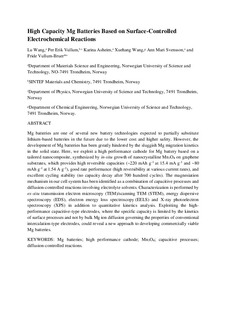| dc.contributor.author | Wang, Lu | |
| dc.contributor.author | Vullum, Per Erik | |
| dc.contributor.author | Asheim, Karina | |
| dc.contributor.author | Wang, Xuehang | |
| dc.contributor.author | Svensson, Ann Mari | |
| dc.contributor.author | Vullum-Bruer, Fride | |
| dc.date.accessioned | 2019-03-14T13:30:56Z | |
| dc.date.available | 2019-03-14T13:30:56Z | |
| dc.date.created | 2018-07-05T12:20:48Z | |
| dc.date.issued | 2018 | |
| dc.identifier.citation | Nano Energy. 2018, 48 227-237. | nb_NO |
| dc.identifier.issn | 2211-2855 | |
| dc.identifier.uri | http://hdl.handle.net/11250/2590072 | |
| dc.description.abstract | Mg batteries are one of several new battery technologies expected to partially substitute lithium-based batteries in the future due to the lower cost and higher safety. However, the development of Mg batteries has been greatly hindered by the sluggish Mg migration kinetics in the solid state. Here, we exploit a high performance cathode for Mg battery based on a tailored nanocomposite, synthesized by in-situ growth of nanocrystalline Mn3O4 on graphene substrates, which provides high reversible capacities (~ 220 mA h g−1 at 15.4 mA g−1 and ~ 80 mA h g−1 at 1.54 A g−1), good rate performance (high reversibility at various current rates), and excellent cycling stability (no capacity decay after 700 hundred cycles). The magnesiation mechanism in our cell system has been identified as a combination of capacitive processes and diffusion-controlled reactions involving electrolyte solvents. Characterization is performed by ex-situ transmission electron microscopy (TEM)/scanning TEM (STEM), energy dispersive spectroscopy (EDS), electron energy loss spectroscopy (EELS) and X-ray photoelectron spectroscopy (XPS) in addition to quantitative kinetics analysis. Exploiting the high-performance capacitive-type electrodes, where the specific capacity is limited by the kinetics of surface processes and not by bulk Mg ion diffusion governing the properties of conventional intercalation-type electrodes, could reveal a new approach to developing commercially viable Mg batteries. | nb_NO |
| dc.language.iso | eng | nb_NO |
| dc.publisher | Elsevier | nb_NO |
| dc.rights | Attribution-NonCommercial-NoDerivatives 4.0 Internasjonal | * |
| dc.rights.uri | http://creativecommons.org/licenses/by-nc-nd/4.0/deed.no | * |
| dc.title | High capacity Mg batteries based on surface-controlled electrochemical reactions | nb_NO |
| dc.type | Journal article | nb_NO |
| dc.type | Peer reviewed | nb_NO |
| dc.description.version | acceptedVersion | nb_NO |
| dc.source.pagenumber | 227-237 | nb_NO |
| dc.source.volume | 48 | nb_NO |
| dc.source.journal | Nano Energy | nb_NO |
| dc.identifier.doi | 10.1016/j.nanoen.2018.03.061 | |
| dc.identifier.cristin | 1595879 | |
| dc.description.localcode | © 2018. This is the authors’ accepted and refereed manuscript to the article. Locked until 23.03.2020 due to copyright restrictions. This manuscript version is made available under the CC-BY-NC-ND 4.0 license http://creativecommons.org/licenses/by-nc-nd/4.0/ | nb_NO |
| cristin.unitcode | 194,66,35,0 | |
| cristin.unitcode | 194,66,20,0 | |
| cristin.unitcode | 194,66,30,0 | |
| cristin.unitname | Institutt for materialteknologi | |
| cristin.unitname | Institutt for fysikk | |
| cristin.unitname | Institutt for kjemisk prosessteknologi | |
| cristin.ispublished | true | |
| cristin.fulltext | postprint | |
| cristin.qualitycode | 1 | |

